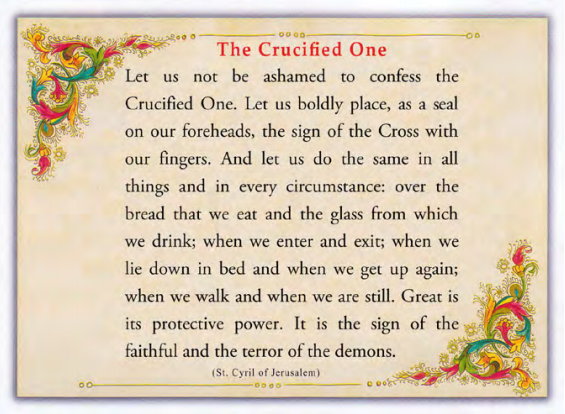In days of old:
Before putting bread in the oven to bake, women would “seal” it with the sign of the Cross.
● Householders would carve a Cross on the front of their houses.
● Craftsmen would adorn works of art and vessels with the Cross.
● Before leaving for battle, soldiers would cross themselves.

Throughout the ages, and until our day:
After lighting incense, the faithful take “flowers from the Cross” [stavroloulouda: the flowers
adorning the Cross on the Feast Day of the Exaltation of the Precious
Cross—these are distributed to the congregation] and make the sign of
the Cross over themselves with them when they are sick, and thereby
regain their health.
● The faithful make the sign of the Cross over the bowl in which they will knead prosphora.
● When basil from the Cross [see note above] is
placed next to the dough, it rises without yeast, if this is done with faith.
● Mothers make the sign of the Cross over their children:
-before they get dressed [in the morning]
-before they go to sleep at night (they bless their pillows)
-before a meal
-before they drink water (by lifting the glass in the air in the form of the Cross)
-when they injure themselves
-when they yawn
-when they cry at night
-when they are praised.
● Builders place a large wooden cross on the roof of an edifice.
● Athletes make the sign of the Cross before a game or event, and again after they win.
● We cross ourselves during unforeseen circumstances such as lightning storms, earthquakes, gunfire, etc.
● The
Cross is thrown into the sea on the Feast of the Theophany, and in
lakes, rivers, and reservoirs, for the sanctification of the waters.
● The Cross is placed as a “guardian” on boats, in cars, trains, and airplanes.
●
Shepherds sprinkle their flocks with Holy Water every spring, giving
thanks to God for protecting them from the dangers of winter and
beseeching Him to bless them.
-They place wooden Crosses on the doors of their folds.
-They give sick animals Holy Water.
-Before
milking, they make the sign of the Cross three times with the palms of
their hands on the milk-pail, and three times again when they have
finished; they then cross themselves three times in thanksgiving to God
for this precious gift of His.
● Monastics cross themselves before every action, and every knot on their prayer rope is made up of nine crosses.
● The clergy “seal” their every action in the Church with the Cross.
●
During droughts, the Priest takes the Cross and goes with the people to
the fields, where they hold a procession with prayers of supplication,
taking with them their umbrellas, since it usually begins to rain after
such a procession. That is, at least, how it used to be.
● The
Macedonian freedom fighters [during the struggle to liberate Macedonia
from the Ottomans in 1912] had a large white Cross on their caps.
● Many
people make the sign of the Cross over themselves as they leave their
houses, so that it might protect them wherever they go. Upon returning
home, they cross themselves again in thanksgiving.
Source-thoughtsintrusive.wordpress.com











0 comments:
Post a Comment